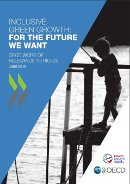|
The first Rio Summit in 1992 was historic for arguing that development has to be sustainable, and that to be sustainable, it must integrate the environmental with the social and the economic dimensions. Twenty years on, that is still a powerful message, but sustainable development is not a reality. sustainable, and that to be sustainable, it must integrate the environmental with the social and the economic dimensions. Twenty years on, that is still a powerful message, but sustainable development is not a reality.
There has been significant progress over the past 20 years. While the world’s population has increased by a third, world GDP has tripled, helping millions of people to work their way out of poverty. The number of children in developing countries who die before the age of five dropped from 100 to 72 per 1 000 live births between 1990 and 2008, and around 90% of children in developing countries are now enrolled in primary school.
However, economic expansion has come at a price to the planet. If we do not protect the environment and its natural resources, this expansion could grind to a halt because we will have destroyed or permanently damaged the water and mineral resources, ecosystem diversity and other natural foundations on which our well-being relies.
If we do not change course, the impact on our quality of life and health will be significant, with an increasing economic burden. More and more financial and human resources will need to be spent to make enough water available and drinkable, keep the land productive, ensure that the air is breathable, and supply industry with the raw materials it needs.
Inclusive green growth offers an optimistic, realistic alternative to countries looking for new sources of growth that make economic, environmental and social sense. Green growth is not a replacement for sustainable development. Together with innovation, going green can be a long-term driver for economic growth.
The OECD  Green Growth Strategy provides a clear framework for how countries can achieve economic growth and development while preventing costly environmental degradation, climate change and inefficient use of natural resources. The Strategy identifiescommon principles and challenges but shows that there is no one-size-fits-all prescription for implementing green growth. Each country needs to devise a strategy tailored to its own circumstances. In all cases, to be sustainable, strategies have to be inclusive and open. Growth has to reduce inequality and the tensions it generates. “Green” cannot be an excuse for protectionism,depriving citizens of choice, driving up costs and stifling innovation. Green Growth Strategy provides a clear framework for how countries can achieve economic growth and development while preventing costly environmental degradation, climate change and inefficient use of natural resources. The Strategy identifiescommon principles and challenges but shows that there is no one-size-fits-all prescription for implementing green growth. Each country needs to devise a strategy tailored to its own circumstances. In all cases, to be sustainable, strategies have to be inclusive and open. Growth has to reduce inequality and the tensions it generates. “Green” cannot be an excuse for protectionism,depriving citizens of choice, driving up costs and stifling innovation.
However, even the best policies are nothing without the political will to implement them. In 2011, Ministers meeting at the OECD welcomed the Green Growth Strategy as a growth strategy first and foremost, and stressed that green growth tools and indicators have the potential to unlock new growth engines and job opportunities. In 2012, the Mexican presidency of the G20 has established green growth asone of its priorities.
It is a key priority for the OECD too. We are exploring how green growth strategies can be applied in the specific context of developing countries and emerging-market economies. And we will continue to work with our members and partner countries to design cost-effective and politically implementable policy measures; robust indicators, data and mechanisms to help track progress; and dedicated platforms and innovative ways to facilitate knowledge sharing and co-operation at the international level. I wish Rio+20 every success in helping to make life better for us all and for future generations.
Angel Gurría
OECD Secretary-General

|